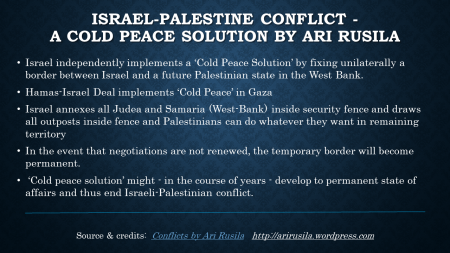Longstanding restrictions on the movement of people and goods to and from Gaza have undermined the living conditions of 1.8 million Palestinians in Gaza. Many of the current restrictions, originally imposed by Israel in the early 1990s, were intensified after June 2007, following the Hamas takeover of Gaza and the imposition of a sc blockade or siege. The situation has been compounded by the restrictions imposed since June 2013 by the Egyptian authorities at Rafah Crossing.
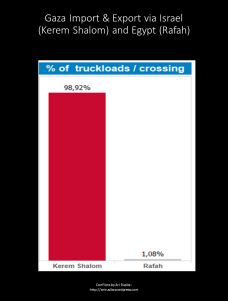
Kerem Shalom vs Rafah 2015
Despite restrictions there has been whole time – even during conflicts/wars – movement of commodities as well Palestinians to and from Gaza via Israeli border crossings. During last months movement of goods has increased via Kerem Shalom Crossing at Israeli border to/from Gaza but is almost non-existent via Rafah Crossing at Egyptian border. Besides official border crossings Egypt is now implementing measures which will totally block unofficial traffic aka smuggling. In my opinion Egypt not Israel is blocking Gaza.
The Rafah Border Crossing
The Rafah Border Crossing lies on the international border between Egypt and the Gaza Strip that was recognized by the 1979 Israel–Egypt Peace Treaty and confirmed during the 1982 Israeli withdrawal from the Sinai Peninsula. The crossing was managed by the Israel Airports Authority until Israel evacuated Gaza on 11 September 2005 as part of Israel’s unilateral disengagement plan. It subsequently became the task of the European Union Border Assistance Mission Rafah (EUBAM) to monitor the crossing. Though Israel and Egypt allow limited imports into Gaza, the economy of Gaza largely relies on illicit trade that flourishes via an alternative “tunnel economy.” Hamas enriches itself at the expense of the Palestinian Authority (PA) by collecting tolls from tunnel operators and import taxes on goods brought into Gaza. This second economy increases ordinary Gazans’ reliance on Hamas rule, which most would prefer to see end. Making peace deal only between Israel and the PA does not solve the Israeli-Palestinian conflict and ignoring Gaza further incentives Hamas to oppose peace with Israel and any deal its Palestinian adversaries conclude.
Since former Egyptian President Mohammed Morsi was ousted in June 2013, the Egyptian military has been trying to eliminate the smuggling tunnels beneath the border in the southern Gaza Strip, destroying them and expanding the buffer zone. Egypt has demolished tunnels e.g. by exploding them, Egyptian army also fires tear gas or throws wastewater inside the tunnels to kill diggers. Rafah crossing with Egypt has been closed almost permanently since October 2014, heavily restricting those who can enter or leave the Gaza Strip. Egypt closed the border after relations soured between the Gazan and Egyptian leaderships after the overthrow of former Egyptian President Mohamed Morsi and the ensuing crackdown on the Muslim Brotherhood and its followers. Egypt has linked instability in the Sinai peninsula to Gaza causing it to isolate the strip. Since 17th September 2015 the Egyptian army has been pumping large volumes of Mediterranean Sea waters into the buffer zone that it began building two years ago, along 14 kilometers of the Palestinian-Egyptian border. The move is the latest attempt to destroy the tunnels dug by Palestinians under the city of Rafah over the years of the Israeli blockade. (Source and more e.g. in Al-Monitor )
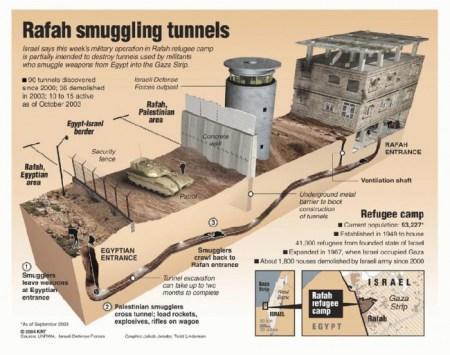
2014—15 Egyptian demolition of homes and terror/smuggling tunnels
In 2008 and 2009, according to media reports and the US Defense Department, the US Army Corps of Engineers trained Egyptian troops to use advanced technological equipment that measures ground fluctuations to indicate tunnel digging. In August 2013, the US Defense Department awarded the defense company Raytheon a $9.9 million contract to continue research and development in Egypt on its version of this technology, which is known as a laser radar vibration sensor.
The tunnels were first constructed immediately after Israel’s disengagement from the Sinai Peninsula, as part of the Camp David agreement between Israel and Egypt. But digging got more intense after Israel declared a blockade on Gaza after Hamas won the 2006 Palestinian elections. Hamas’s government started to flourish on what economists called the booming “tunnel economy” until current Egyptian President Abdel Fattah al-Sisi joined Israel in trying to destroy it.
In October 2014 Egypt announced that they planned to expand the buffer zone between Gaza and Egypt, following a terrorist attack from Gaza that killed 31 Egyptian soldiers. The buffer was created “in a move meant to halt the passage of weapons and militants through cross-border smuggling tunnels but which also puts more pressure on the Palestinian militant Hamas group.” The buffer zone originally was 500 meters, following the announcement of the expanded buffer zone many residents voluntarily left the area. Ibrahim Mahlab the Prime Minister of Egypt announced that any residents unwilling to move willfully would be forcefully removed from their homes. Between July 2013 and August 2015, Egyptian authorities demolished at least 3,255 residential, commercial, administrative, and community buildings in the Sinai Peninsula along the border with the Gaza Strip, forcibly evicting thousands of people.
On 17 November, 2014, Egypt announced that the buffer zone would be doubling to 1 km due to the longer than expected tunnels discovered, in addition to a night time curfew for the area. On January 8, 2015, Egypt’s expansion resulted in the destruction of about 1,220 homes, while destroying more than 1,600 tunnels. Some tunnels discovered ranged over 1 kilometer long and contained lighting, ventilation and phone systems. In February 2015, in response to the buffer zone, ISIS beheaded 10 men they believed were spies for Mossad and the Egyptian Army. In June 2015 Egypt completed its digging of a ditch by the Rafah Crossings, 20 meters wide by 10 meters deep. (Source and more e.g: Wikipedia )
Over the past months Egyptian military bulldozers have also destroyed many Egyptian homes to create a buffer zone of at between 500 and 1,000 metres on the Egyptian side, and 1,000 metres. Entire neighborhoods have been flattened being gutted.
Egypt floods the rest of Gaza’s tunnels with seawater
According MEE – Middle East Eye report Egyptian military vehicles are transferring Mediterranean Sea water to the Rafah border, to fill a newly-built crude canal, flooding and destroying the lifeline tunnels connecting Egypt and blockaded Gaza. By canal the Egyptian government is trying to economically crush Hamas, an ally of the Muslim brotherhood. Egypt is planning that sea water will flood into any remaining undiscovered tunnels and completely destroy them. Most tunnels are usually 20 meters deep, and can stretch for three hundred meters inside Egyptian Rafah. Israel also tried to fight Gaza’s tunnels by digging a canal and pumping sea water into the 14 km borderline with Egypt, but due to environmental damage and danger to natural aquifer water systems, it built a separation wall instead; deep into, and above, the ground.
Egyptian military personnel won’t speak openly of the nature of the project, but some local experts have said the aim is to create fish farms. Water pipes can be seen on the Egyptian side of the border-leading from the beach area into the west of the city, to an area filled with supply tunnels. A local water engineer said that pumping sea water into natural clean-water aquifers will increase salinity twenty-fold.
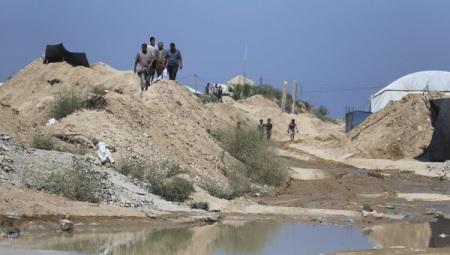
Palestinians inspect the damage after Egyptian forces flooded smuggling tunnels dug beneath the Gaza-Egypt border, in Rafah in the southern Gaza Strip September 18, 2015. | Photo: REUTERS/Ibraheem Abu Mustafa
Mayor of Rafah, Subhi Radwan believes this could lead to the forced migration of the local population. “The sea water is leaking into the clean aquifer, damaging the ground structure and pure water,” he said. Radwan said that drinking water, for the population, will not be available soon, as dirty salt water is pushed into the already damaged plumbing system of Gaza. “This will also deprive farmers of the ability to plant consumable vegetables and all forms of fresh plants which rely on clean aquifer waters,” the mayor added.
Economic analyst Moein Rajab told Al-Monitor that the pumping of salt water into the tunnels will affect agriculture and render farmlands unproductive as salt levels rise. As such, large tracts of Palestinian agricultural land that stretches along the Egyptian border will be made useless, leading to a marked decrease in agricultural production. Rajab added that soon after, the area’s inhabitants would be forced to leave as the topsoil is destabilized, further exacerbating the current Gaza Strip housing crisis. He explained, “Due to the fact that houses are so close to the border — mere hundreds of meters away — homes will become threatened with demolition or damaged to the point of being unlivable, with their foundations buckling as the earth liquefies. As a result, inhabitants will be forced to abandon their homes, which will add problems and further exacerbate the housing crisis engendered by the scarcity of building materials, blockade and pitiable economic situation.”
The Kerem Shalom crossing
Kerem Shalom in Israel is the main – and now practically only – border crossing to and from Gaza for goods (People are using more Erez crossing in Northern Gaza). Office for the Coordination of Humanitarian Affairs (OCHA) is part of the United Nations Information System on the Question of Palestine (UNISPAL) agency monitoring and reporting e.g. Gaza’s situation to international community. Its statistics show clearly where movement of commodities to and from Gaza take place. To the text frame below I have collected from OCHA reports the main points about import and export of Gaza through Israel on August 2015:
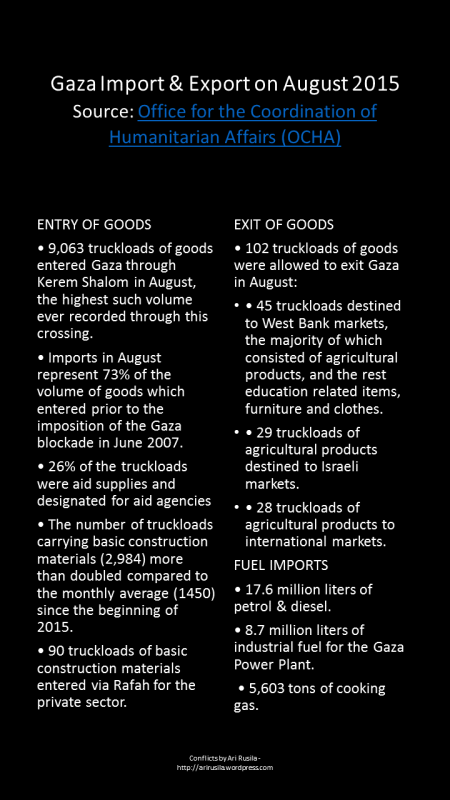
Gaza Import/Export, August 2015
And here is wider picture of Gaza crossings in infographic:
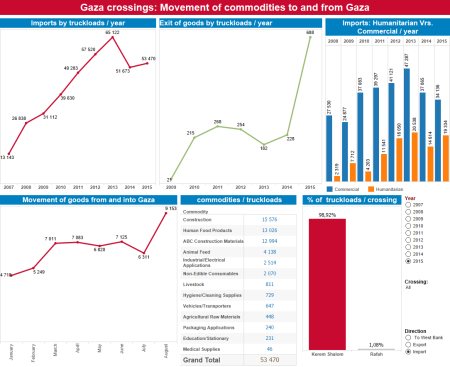
The Kerem Shalom crossing is relatively small and is not enough for the entry of all of Gaza’s needs. An average of 300 to a maximum of 700 trucks enter every day. To increase the truckloads of supplies that enter Gaza from Israel and speed up efforts to rebuild the territory, the Dutch government donated a new security scanner on July 2015. Some 1,000 trucks are expected to cross with the new scanner, according to COGAT and the Dutch Foreign Ministry. (Source. The Times of Israel )
My conclusions
Hamas’ economic well-being was in large part dependent on its system of smuggling tunnels snaking underneath the Gaza border with Egypt. The supply lines that have fed it cash, arms, goods, luxury items, fuel, and cement for its terror-tunnel industry suddenly were gone. These goods, which were smuggled into Gaza at obscenely low prices at the expense of Egyptian citizens, were no longer flowing in due to the closure of the tunnels. The economy of Hamas is weakening as Egypt has closed main part of over one thousand smuggling tunnels on Gaza border; before that Hamas administration got remarkable income from smuggling activities.
Gaza’s isolation was imposed originally to delegitimize and undermine Hamas’ leadership. Palestinian Authority or better say Fatah was hoping to produce positive economic development in the West Bank which could lead Gazans to overturn Hamas rule. The opposite came true as Hamas’ control grew tighter. During last year there has been talks about national reconciliation between Hamas and Fatah. The Hamas-Israel dialog is the last example that instead unity the split between Hamas and Fatah as well between the West Bank and Gaza Strip is even wider than before.
This situation can at best to lead long-term cease-fire between Israel and Hamas. Part of deal is lifting of an eight-year blockade placed on the Gaza Strip, less restriction for goods and people to go over border, importing goods to Gaza through a Cyprus port overseen by NATO representatives (until a floating offshore port can be developed). Hamas-Israel Deal could pave way for the ‘Cold Peace Solution’ and beyond. (More in Hamas and Israel on Verge of the Deal )
EU claims that imaginary Gaza blockade is the reason for slow reconstruction in Gaza strip while the main reason is corruption and misuse of funds. (More e.g. in Instead of Gaza’s Reconstruction Donor Aid Finances Terrorism And Corruption ). Besides emergency relief the international community gives also huge donations for capacity building activities. One problem however is that the impact of the international assistance is poor if not even non-existent in relation to sustainable development. As The Palestine Economic Policy Research Institute (MAS) concluded “it has been almost impossible to trace any positive impact of these mobilized resources on the ground”. More about MAS analysis in Placebo effect for people and society with 20 bn bucks .
So called Gaza blockade or siege is one of the main causes or excuse – depending from viewpoint – for flotillas, BDS, EU’s labelling plans, anti-Semitism, donations to Hamas, humanitarian crisis etc. Given the facts referred above one could conclude that blaming Israel for blockade is at least unjust.
